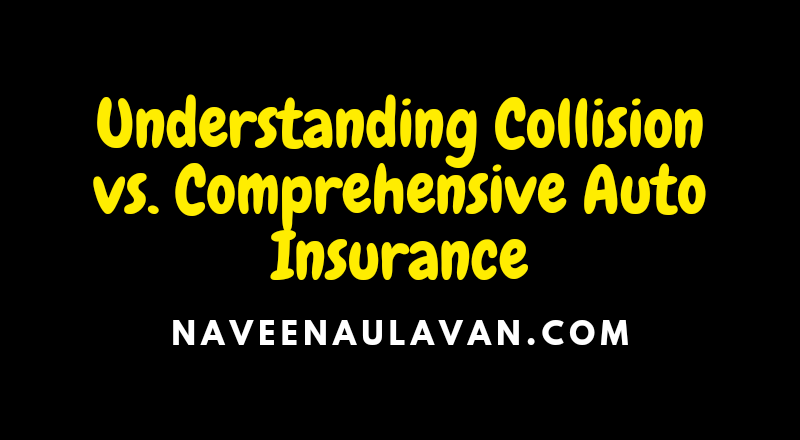Auto insurance is a crucial aspect of vehicle ownership providing financial protection in the event of an accident theft or damage. When considering auto insurance coverage two common options that come up are collision and comprehensive insurance. Understanding the differences between collision and comprehensive insurance can help individuals make informed decisions regarding their coverage. In this article we will delve into the details of collision and comprehensive auto insurance exploring their definitions coverage and when they are beneficial.
1. Collision Auto Insurance
1.1 Definition
Collision auto insurance as the name suggests covers the cost of repairs or replacement of a vehicle if it is involved in a collision with another vehicle or object. This type of insurance is designed to protect the policyholder’s vehicle regardless of who is at fault for the accident.
1.2 Coverage
Collision insurance typically covers the following:
- Damage caused by a collision with another vehicle.
- Damage caused by a collision with an object such as a tree or telephone pole.
- Damage caused by flipping over.
Collision insurance may also cover the costs associated with a hit-and-run accident where the responsible party flees the scene and cannot be identified.
1.3 Beneficial Scenarios
Collision auto insurance is most beneficial for individuals who:
- Have a financed or leased vehicle: Lenders often require collision insurance to protect their investment.
- Own a newer or more valuable vehicle: The cost of repairs or replacement for a new or high-value vehicle can be substantial.
- Want extra peace of mind: Having collision insurance provides additional protection and reduces out-of-pocket expenses in the event of an accident.
2. Comprehensive Auto Insurance
2.1 Definition
Comprehensive auto insurance provides coverage for various non-collision incidents that may cause damage or loss to a vehicle. This type of insurance is designed to protect against events beyond the policyholder’s control such as theft vandalism natural disasters or falling objects.
2.2 Coverage
Comprehensive insurance typically covers the following:
- Theft: Compensation in case the vehicle is stolen or parts are stolen from it.
- Vandalism: Coverage for damages resulting from deliberate acts of vandalism such as graffiti or broken windows.
- Natural disasters: Protection against damage caused by events like hurricanes tornadoes hailstorms earthquakes or floods.
- Falling objects: Compensation for damages resulting from falling objects such as trees or branches.
- Fire: Coverage for damages caused by fire or explosions.
- Animal collisions: Protection against damages resulting from collisions with animals such as deer.
2.3 Beneficial Scenarios
Comprehensive auto insurance is most beneficial for individuals who:
- Live in areas prone to natural disasters: Comprehensive insurance helps protect against the damages that can result from these unpredictable events.
- Own a vehicle at risk of theft: Comprehensive insurance will cover the cost of replacing stolen vehicles or their parts.
- Wish to protect their vehicle from non-collision-related damages: Comprehensive insurance provides a comprehensive level of protection for various events.
3. Collision vs. Comprehensive Insurance
3.1 Coverage Comparison
The primary difference between collision and comprehensive auto insurance lies in the types of incidents they cover. Collision insurance focuses on accidents involving collisions with other vehicles or objects while comprehensive insurance covers damages resulting from incidents like theft vandalism natural disasters and falling objects.
3.2 Factors to Consider
When deciding whether to purchase collision or comprehensive insurance several factors should be taken into account:
- Vehicle value: The age make model and value of the vehicle play a significant role in determining the necessity of collision or comprehensive insurance.
- Personal circumstances: The area in which the policyholder lives their driving habits and how frequently they park their vehicle in public spaces should be considered when assessing the need for comprehensive insurance.
- Policyholder’s risk tolerance: Those who desire extra protection and are willing to pay higher premiums may opt for both collision and comprehensive insurance coverage.
3.3 Combining Collision and Comprehensive Insurance
In some cases individuals may choose to carry both collision and comprehensive insurance coverage. This combination provides a higher level of protection covering a wider range of incidents that can damage or result in the loss of a vehicle. However it’s important to note that having both types of coverage will result in higher insurance premiums.
Conclusion
Collision and comprehensive auto insurance policies offer valuable protection for vehicle owners. Collision insurance covers damages resulting from accidents involving collisions with vehicles or objects while comprehensive insurance covers damages resulting from incidents like theft vandalism natural disasters and falling objects. The choice between collision and comprehensive insurance depends on various factors such as the vehicle’s value personal circumstances and risk tolerance. Combining both collision and comprehensive insurance offers a higher level of protection but comes with increased premiums. Ultimately understanding the differences between collision and comprehensive insurance enables individuals to choose the coverage that best suits their needs and provides them with peace of mind on the road.
